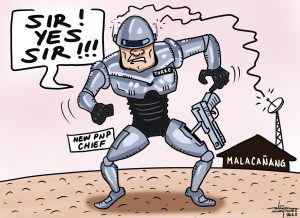We feel that we are already like a broken record often repeating as subject in our column the issue about “white elephants” component in some overpass projects of the government in Davao City.
We say “component” because the “white elephants” we are referring to are only part of the entire overpass projects. These are the elevators installed in some of the overpasses. The elevators, the purpose of its installation is novel, are to help senior citizens, those with heavy baggage, those carrying with them babies still unable to walk, and of course people with physical disabilities cross roads safe from accidents.
But as we have personally observed the elevators installed one each on both ends of the overpasses, have never been put to use. Possibly these were only made available to the public when these were tested and presented for inspection by the agency implementing the project and for showing the same to the Commission on Audit (COA).
Our harping however was somehow limited to such projects in the third district as we have more opportunities to have a look at the overpasses in that area. Thus, we are more familiar of the slow but sure deterioration of the elevators in the overpasses located in Mintal and Calinan.
Last Wednesday we had to send off a family visitor to the Davao Airport located in the city’s second district. When we were on our way home we got stuck in traffic somewhere at the portion of the Buhangin-airport road some 800 meters away from the underpass.
Guess what we have seen while waiting for the vehicles to move? We saw the elevators on the overpass in that area in worst condition than the ones in the Mintal and Calinan overpasses.
Believe you us; the elevator door on the upper level on one end is already broken. One panel is leaning keeping the lift door partially open. So, if the lift is on the ground then there is so much danger lurking in that nearly half open door of the elevator shaft.
Meanwhile, at the other end of the said overpass the ground door of the elevator shaft is fully opened. And what we saw made us gnash our teeth in disbelief. The opened door of the elevator shaft has been converted into a dumping area of what looked like used cardboard boxes. Or was it plywood sheet?
The media man in us let out the urge to take pictures of the overpass elevator situation. But as we said we were stuck in traffic and more unfortunately we were on the inner lane. And there was no available space along that road to park our vehicle. Thus, we could only shake our head in frustration.
But wait. Is not the regional office of the COA located along the same highway? How come not a single employee of that agency was able to take notice of the deplorable condition of that particular overpass? Even if the COA employees could be riding daily on their air-conditioned, tinted glass windowed vehicles, it is highly impossible not to have seen the overpass and its elevator components.
Anyone of them could have reported the situation to their respective bosses so that the latter can call the attention of the project’s implementing agency – the DPWH without doubt.
Apparently, these COA personnel rather prefer to be blind so as not to be reminded of their own infidelities in the mandate of their duties and responsibilities as guardians of government funds.
Meanwhile, we also have people at the DPWH with similar characteristics as those at the COA. Perhaps, after their acceptance of the overpass projects concerned based on what could be dubious inspection process, none of them has ever gone back to the overpass sites to do some post inspections. Had they done so, they could not have missed the sorry state not just of the elevator component but of the entire project as well.
But if only to give benefit to doubts, we are not actually ruling out the possibility that the non-use of the elevators since the overpasses completion could be due to the failure of the agencies concerned to provide for budget to pay for electric bills in the operation of the lifts. Operating the two lifts in each overpass could cost the government a fortune in terms of energy bill as well as salary for the lift operators.
We can be sure that the DPWH, and the COA for that matter, may not have forged an agreement with the local government of Davao City in regards to who should pay for the electric bills as well as the salary of the operators. The latter personnel must be provided if the lifts are to remain functional for long.
But then again, after the many times we raised the issue in this space no one from the three government agencies concerned reacted. And these could only be the possible reasons: Its officials are not reading local newspapers; they are deaf and blind; or they are simply callous and insensitive.
Change is coming? What change? Where is it now?

